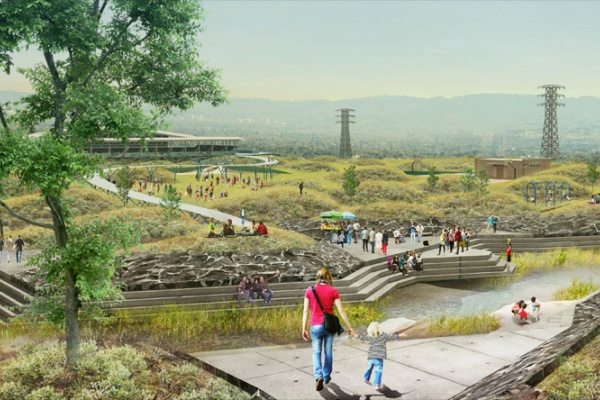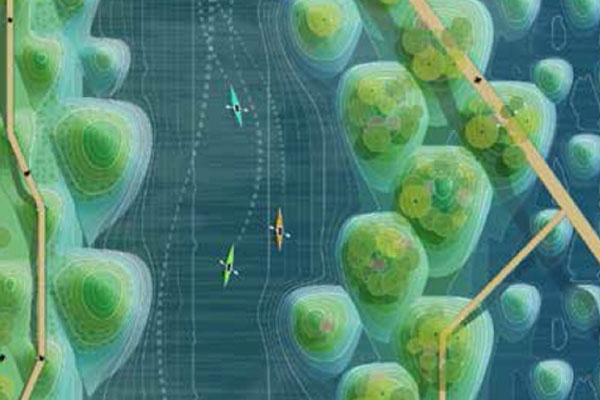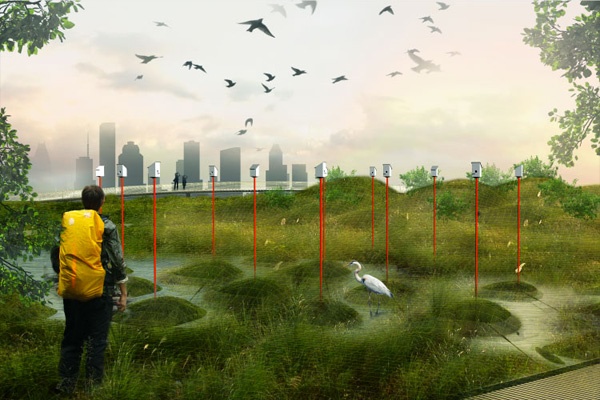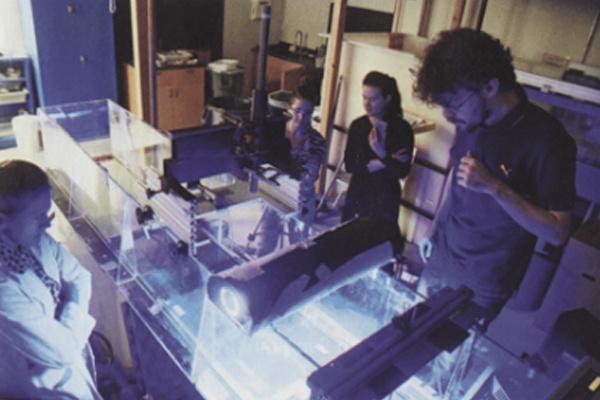Our Research Strategies for urban stormwater wetlands Los Angeles & Houston

Design rendering of the project’s wetland designs applied in Los Angeles to enhance recreational opportunities. Photo credit: Jonah Susskind
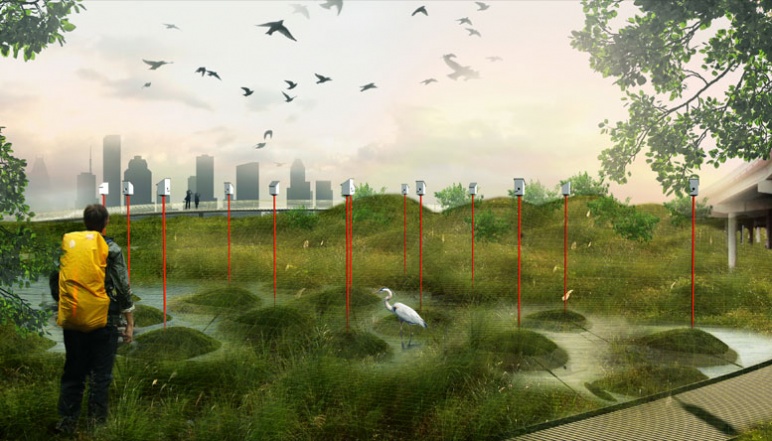
Design rendering of the project’s wetland designs applied in Houston to create an ecologically-rich wetland preserve. Photo credit: Jonah Susskind
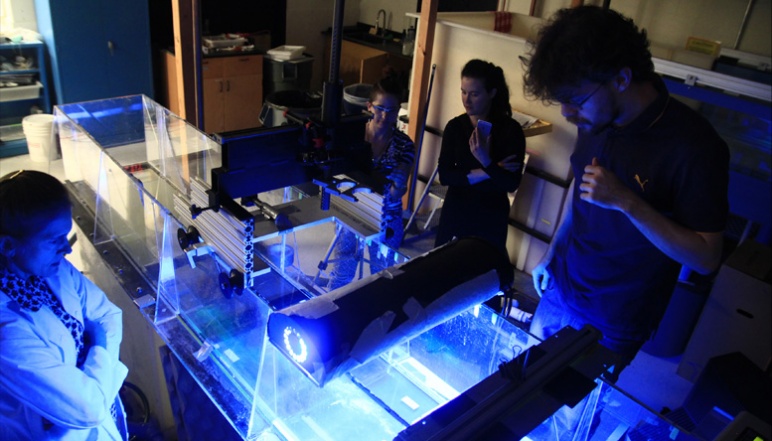
The research team testing designs in the Nepf Environmental Fluid Dynamics Lab. Photo credit: Waishan Qiu
Lab experiment showing how islands help to evenly distribute water flow across a wetland, improving water treatment. Video credit: Waishan Qiu and Celina Balderas Guzman
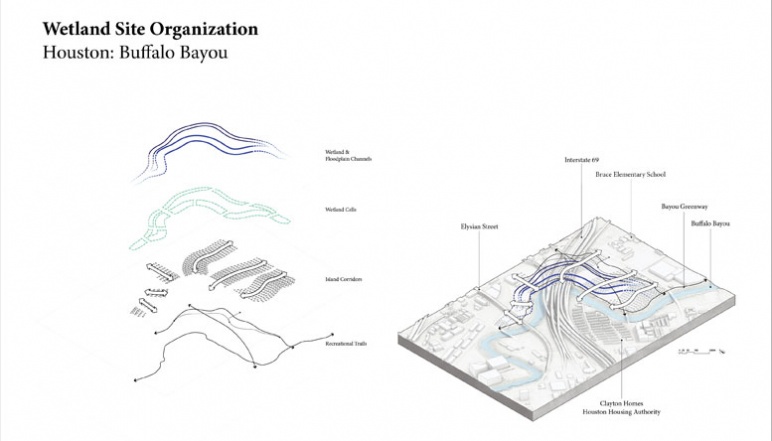
Diagram showing how the project’s designs are applied at the urban scale to create a wetland park. Photo credit: Waishan Qiu
Principal Investigators
Challenge:
How can urban landscape design mitigate the harmful effects of polluted storm water runoff in cities?
Research Strategy
- Evaluated in lab experiments wetland designs that maximize water treatment, promote ecological richness, and provide recreational opportunities
- Used Los Angeles and Houston as test sites to illustrate conceptually how the modular and scalable designs could be applied in real urban sites
- Generated and distributed design guidelines to urban planners and policymakers
Project description
This research project explored the potential of constructed wetlands not only as a stormwater solution but more fundamentally as urban resiliency infrastructure. Managing stormwater is a key problem in securing urban resiliency worldwide. Stormwater’s volume and toxic mix of pollutants threaten the ecological function of water systems, impairing critical ecosystem services cities need for resiliency: water quality, aquifer recharge, flood protection, soil conservation, urban heat island reduction, biodiversity, and others. Plus, stormwater represents a potential water source for cities that increasingly face water shortages. As urban expansion accelerates around the world— the UN estimated an additional 2.5 billion people will live in cities by 2050— the stormwater problem will worsen as impervious surfaces and ecological degradation increase. Investigating constructed wetlands as a flexible, holistic, and multi-functional urban infrastructure for stormwater is relevant not only for retrofitting existing North American cities, but also as a low-cost solution for new development in the Global South.
To minimize its impact and enable possibilities for re-use, stormwater must be treated. Unfortunately, upgrading water infrastructure requires huge financial investment at a time of dwindling federal funds. Constructed wetlands have been shown to effectively clean water at a lower cost than conventional water treatment plants. However, there is an overall lack of design guidance on stormwater constructed wetlands and almost no research on their integration in cities. This project served as an opportunity to develop the specifically urban constructed wetland as a multi-functional resiliency feature for cities to improve ecosystem services, re-use water, and create amenities in cities.
The research team created design guidelines for urban constructed wetlands that fulfill ecological and urban design goals at the same time as treating stormwater. The design guidelines were developed using two cities as example sites: Los Angeles as a drier city and Houston as a wetter city. Los Angeles and Houston are America’s top two cities facing water shortages, and both are growing rapidly. The urban design team and the engineering team collaborated to design the wetlands and their integration into the urban fabric. Prototypes were built and used to investigate the geometry of wetland designs and test their performance potential via tracer studies run in the Nepf Environmental Fluid Dynamics Lab.
This project has offered a well-articulated, scientifically-based vision of urban constructed wetlands for stormwater and their ecological and amenity benefits, and has demonstrated the full potential of wetlands as holistic urban resiliency infrastructure. The design guidelines have been disseminated via academic articles, meetings with stakeholders in Los Angeles and Houston, and lectures at conferences and major engineering firms. Stakeholders can use these guidelines to push forward a wetland project in their own city, promote more sustainable ideas for stormwater, or create stormwater and constructed wetland policies.
Outcomes
- Identified optimal wetlands designs that are able to efficiently process stormwater while providing further ecological functions
- Designed precise topographical configurations that allow for better hydraulic performance at a lower cost
- Detailed how to implement these designs in urban sites such as Los Angeles or Houston
- Elucidated how this plan will also be a source of recreation and provide benefits to the public of these cities
Publications
Island topographies to reduce short-circuiting in stormwater detention ponds and treatment wetlands
Celina Balderas Guzman, Samantha Cohen, Manoel Xavier, Tyler Swingle, Waishan Qiu, Heidi Nepf, Ecological Engineering, 2018
Numerical modeling study to compare the nutrient removal potential of different floating treatment island configurations in a stormwater pond
Manoel Lucas machado Xavier, Johannes Gerson Janzen, Heidi Nepf, Ecological Engineering: The Journal of Ecosystem Restoration, 2018
Design guidelines for urban stormwater wetlands
Celina Balderas Guzmán, Heidi Nepf, Alan M. Berger, 2018
News
Additional Details
Impact Areas
- Water
- Climate & Sustainability
Research Themes
- Water Resources & Infrastructure
- Sustainability & Adaptation
- Economics, Policy, & Practices
Year Funded
- 2015
Grant Type
- Seed Grant
Status
- Completed



